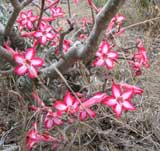|
|
 |
 |
|
National Biodiversity Strategy and Action Plan (NBSAP)

Despite the small size of the country, Swaziland is topographically and climatically very diverse. This diversity of environmental conditions supports a correspondingly high biological diversity.
In 2002 a National Biodiversity Strategy and Action Plan (NBSAP) has been compiled with the primary objective to prevent the erosion of Swaziland''s biodiversity.
NBSAP does not stand alone but forms part of the Swaziland Environment Action Plan (SEAP). Swaziland supports a diverse assemblage of habitats which are home to a wide range of organisms.
Although the information base on Swaziland''s biodiversity is still incomplete, survey work has shown that a significant portion of southern Africa''s plant and animal species occur here. The eastern region of Swaziland, for example, forms part of the Maputaland Centre of Plant Diversity (one of the World''s "hotspots" of floral, as well as faunal, species richness and endemism), while the western region falls within another area of global significance, the Drakensberg Escarpment Endemic Bird Area.
The value of Swaziland''s biodiversity has long been recognised by Swazis who make use of it on a daily basis for various reasons including: traditional medicine, food, building material, traditional attire. Traditional systems of conserving biodiversity also exist but have not been documented and are currently being eroded.
The International Convention on Biodiversity (Article 2) defines biodiversity as "the variability amongst living organisms from all sources including, inter alia, terrestrial, marine and other aquatic ecosystems and the ecological complexes of which they are part". Put more simply, biodiversity is the variety of plants, animals and other life forms, the genetic material they contain and the ecosystems which they form. Biodiversity can be seen as three distinct components which includes:
- Genetic diversity: the genetic variations within a species, that usually results from environmental selection pressure or from genetic mutations in reproductive cells. Genetic variations can result in distinct populations within the same species, often resulting from the diversity of habitats which are occupied by a single species.
- Species diversity: the variety of different species which have emerged from evolutionary processes. The processes which generate genetic variation also create species, except the magnitude of differences is larger that in the case of species. When two organisms'' genetic material differs to the extent that they are unable to produce fertile off-spring, then they may be considered different species.
- Ecosystem diversity: the different communities of plant and animal species that create the numerous habitats in Swaziland. The various combinations of different plant and animals species create different ecosystems as the various organisms interact with each other and the physical environment (minerals, water and climate) around them.
The NBSAP describes the issues in more detail.
As Luke concludes: “Essentially, what you’re getting is retro replica watches uk looks backed by the latest horological tech.
Related pages:
Biodiversity Capacity Building Needs Assessment
Convention on Biological Diversity
Convention on Biological Diversity - Swaziland Status
Swaziland Environment Action Plan (SEAP)
Related links:
Convention on Biological Diversity
|
|
 |
|
 |
|
 |
 |
Responsible Organisation:
SEA
|
|
 |
|
 |
|